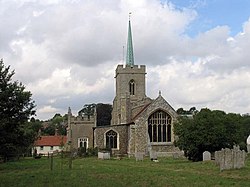Braughing
| Braughing | |
| Hertfordshire | |
|---|---|
 Braughing | |
| Location | |
| Grid reference: | TL395251 |
| Location: | 51°54’27"N, -0°1’39"E |
| Data | |
| Postcode: | SG11 |
| Local Government | |
| Council: | East Hertfordshire |
Braughing is a village in Hertfordshire lying between the rivers Quin and Rib in the east of the county. It was the site of a significant Roman town, but now a minor village, if a pretty one.
History
Prehistory
There is some evidence of human activity in the Mesolithic, Neolithic and Bronze Age, but settled habitation began in the Iron Age, around the 3rd century BC. The site of what was to become Braughing was probably a trading post, situated on the navigable extreme of the Rib, providing a route to the larger River Lea. In the late pre-Roman period it may have been the capital of the Trinovantes and the seat of such kings as Addedomarus and Tasciovanus.
Roman town
At Ford Bridge, near Braughing there was a significant town in Roman times, situated close to several major Roman roads, including Ermine Street (now the route of the A10), Stane Street (now the A120) and the Icknield Way, and covering at least 89 acres. The town was a Roman industrial centre for the manufacture of pottery.
When the River Rib is in full flood, bricks, tiles and other more interesting artefacts from the Roman settlement are washed from its banks.[1]
The Latin name of the town is, as yet, unknown.
Anglo-Saxon times
After the Roman period it was settled by the Ancestral English; the Anglo-Saxons. The earliest form of the name Braughing is Breahingas, which is Old English for "the people of Breahha", who was presumably a local leader.
The village is listed in the Domesday Book of 1086 as Brachinges.
Gatesbury
Gatesbury was a hamlet of which little remains, lying to the east of the B1368 close to the Puckeridge junction. Originally part of Westmill parish, Gatesbury is now firmly within the parish of Braughing. Its name originates from the Gatesbury family, who held the manor from the late 12th century up to the 15th century, when it was passed to the FitzHerberts.
Customs

Pork sausages
The village is famous for the Braughing Pork Sausage first made in 1954 by Douglas White and his wife Anna. The recipe has remained the same and the sausages are still made in the shop using the original recipe.[2]
Old Man's Day
Old Man's Day is a village custom remembering an event of 1571.
On 2 October 1571, as the funeral bell was being tolled, the coffin of a local farmer, Matthew Wall, was being carried down Fleece Lane towards the parish church, St Mary the Virgin. Matthew's fiancée and other mourners were deeply distressed. He was only a young man.
As they made their way to the funeral service, one of pallbearers slipped on the damp autumn leaves and they dropped the coffin - waking young Matthew, from what was simply a deep sleep. Confused and wondering wherever he was, he began frantically hitting the inside of the wooden case with his fist. The mourners removed the lid and were overjoyed to find him alive and well.
Matthew had been in a coma and had been suffering from what is believed to be a form of epilepsy. A year after this strange event he married his beautiful fiancée and lived many more years. When eventually he did die in 1595, his will made financial provision for Fleece Lane to be swept each year, after which the funeral bell, and then a wedding peal, were to be rung. The money, invested in Braughing Parish Charities also paid for his grave to be pegged with brambles to prevent grazing sheep from damaging it.
The dates of Matthew Wall's funerals are recorded on a tapestry on a wall in the parish church. The 2nd October is, to this very day, known as Old Man's Day. The tradition still continues and schoolchildren now sweep the leaves from the lane, the bells are rung, and a short service is held at Matthew Wall's graveside.[3]
Outside links

| ("Wikimedia Commons" has material about Braughing) |
- Braughing community website
- Braughing at Roman-Britain.org
- Pictures of Braughing and the area on Geograph.co.uk
- Braughing (A Guide to Old Hertfordshire)
- Ford Bridge, Braughing Grade II listed - British Listed Buildings
- Picture of the fording of the River Rib at Braughing from Geograph.org.uk